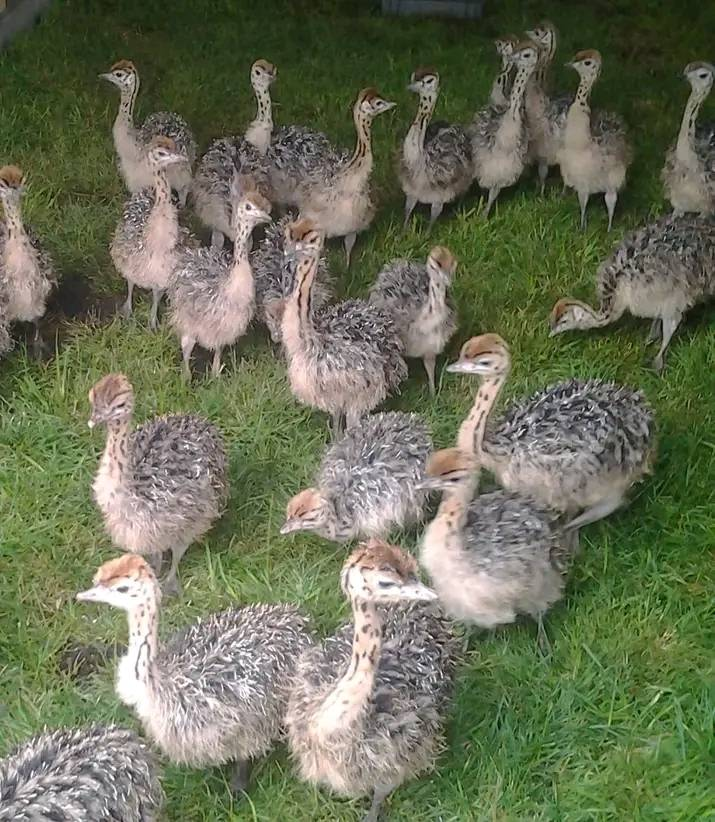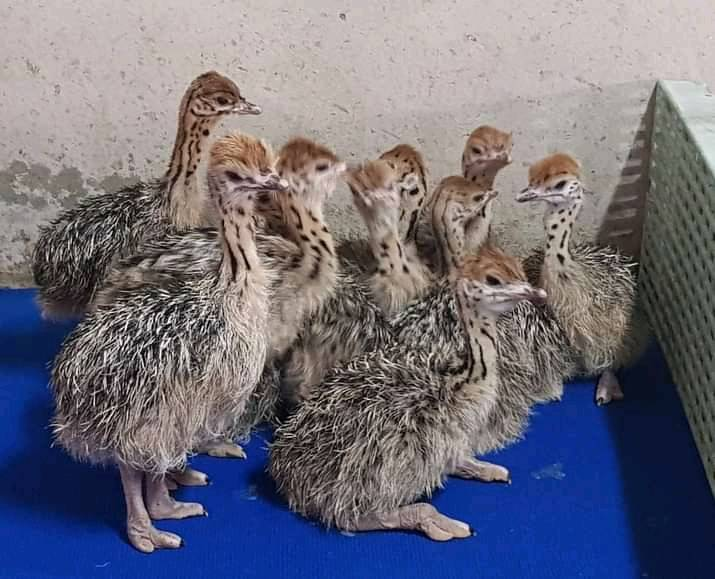Ostriches
NOTE: OSTRICHES ARE HEARD ANIMALS, THEIR GOOD IN PAIRS OR MORE. YOU MUST BUY AT LEAST 2 CHICKS EXCEPT YOU HAVE ONE OSTRICH BIRD ALREADY. HAVE THE RIGHT TO DENY SALES.
Breeding pairs are from different genetics to ensure you receive the healthiest chicks and highest hatch rates.
Eggs are ship USPS locally and FedEx, or DHL international while chicks are locally pickup or arrange for delivery. (we talk about that further)
(HATCHING EGGS AVAILABLE NOW)
Chicks will be available from the first batch of incubation.
All chicks sold are sexed before placed as available. we don't sell unsexed Ostrich chicks.
We rarely ship chicks (How ever transport can be arrange if not visible for pick up.
We ship eggs locally and international (USPS ,UPS,Fedex and DHL)
Available Chicks/ - PRICE LIST
Chicks -sexed (2-3weeks) ___$300 each
Hatching egg________$55 each

Ostriches cannot fly, but don't feel too sorry for them. The ostrich is the fastest bipedal runner in the world, capable of reaching speeds up to 45 miles per hour--about twice what the fastest human can achieve. What's more, an ostrich can maintain this speed for up to half an hour.

To dispel the ancient libel, ostriches do not bury their heads when faced with danger--a species that did so would hardly be able to survive for more than 120 million years. They do, however, stretch their long necks flat on the ground when they sleep; from a distance, it can look as though their heads are buried. Of the three main varieties of ostriches, only the African black ostrich (Struthio camelus domesticus) is found in captivity. They are farmed for meat, leather, and feathers in at least 50 countries and just about all climatic conditions, from Alaska to equatorial Africa. Ostriches have the best feed-to-weight ratio gain of any farmed land animal in the world and produce the strongest commercially available leather.
Of the three main varieties of ostriches, only the African black ostrich (Struthio camelus domesticus) is found in captivity. They are farmed for meat, leather, and feathers in at least 50 countries and just about all climatic conditions, from Alaska to equatorial Africa. Ostriches have the best feed-to-weight ratio gain of any farmed land animal in the world and produce the strongest commercially available leather.
The ostrich's eyes are about the size of billiard balls. They take up so much room in the skull that the ostrich's brain is actually smaller than either one of its eyeballs. This may be why the ostrich, despite its tremendous running speed, is not very good at eluding predators: It tends to run in circles.
 ostrich's intestines are 46 feet long--about twice as long as those of a human. This enables the bird to get the most out of the tough plants it eats. To help with digestion, it also swallows sand and small stones to break down food in its gizzard. Ostriches in captivity have been known to swallow just about anything that can fit down their gullet, including bicycle valves, alarm clocks, and even small bottle.
ostrich's intestines are 46 feet long--about twice as long as those of a human. This enables the bird to get the most out of the tough plants it eats. To help with digestion, it also swallows sand and small stones to break down food in its gizzard. Ostriches in captivity have been known to swallow just about anything that can fit down their gullet, including bicycle valves, alarm clocks, and even small bottle.
The ostrich is the largest living bird in the world. An ostrich chick grows one foot taller each month until it is seven or eight months old. Adult ostrich roosters are six to ten feet in height and can weigh as much as 340 pounds. Because of their prodigious size, ostriches were occasionally used for riding or pulling chariots in ancient Egypt; the practice never really took off, because the ostrich has a nasty temper.
This great bird has only two toes; all other birds have three or four. Ostriches kick forward, not backward, because that's the direction in which their knees bend. Ostriches never need to drink water--some of it they make internally, and the rest is derived from the vegetation they eat.

Although the ostrich egg is the largest of all eggs, it is the smallest egg in relation to the size of the bird. A three-pound egg is only about 1 percent as heavy as the ostrich hen; by contrast, a kiwi's egg--the largest in comparison to the mother--is 15 to 20 percent of the mother bird's mass. An ostrich egg is equivalent in volume to two dozen chicken eggs.
Physiologus, an early Christian text compiled around the second century A.D. and a popular read in the Middle Ages, asserts that the ostrich incubates its eggs by staring at them. It was widely held at the time that vision was the effect of special "seeing" rays emanating from one's eyes; thus, the heat in the gaze of the ostrich hatched its chicks. The author of Physiologus presents this as an allegory to inspire worshippers to keep their eyes on Christ.
Contact: (610) 614-6266
Email: mittyfarms@gmail.com
17 Hollow Rd Telford, Pennsylvania(PA), 18969
www.mittyfarms.com
Breeding pairs are from different genetics to ensure you receive the healthiest chicks and highest hatch rates.
Eggs are ship USPS locally and FedEx, or DHL international while chicks are locally pickup or arrange for delivery. (we talk about that further)
(HATCHING EGGS AVAILABLE NOW)
Chicks will be available from the first batch of incubation.
All chicks sold are sexed before placed as available. we don't sell unsexed Ostrich chicks.
We rarely ship chicks (How ever transport can be arrange if not visible for pick up.
We ship eggs locally and international (USPS ,UPS,Fedex and DHL)
Available Chicks/ - PRICE LIST
Chicks -sexed (2-3weeks) ___$300 each
Hatching egg________$55 each
Ostriches cannot fly, but don't feel too sorry for them. The ostrich is the fastest bipedal runner in the world, capable of reaching speeds up to 45 miles per hour--about twice what the fastest human can achieve. What's more, an ostrich can maintain this speed for up to half an hour.

- Ostriches are the largest birds in the world, standing up to 9 feet (2.8 meters) tall and weighing as much as 320 pounds (145 kg).
- They are flightless but can run at speeds up to 45 mph (72 km/h), using their powerful legs to escape predators.
- Ostriches lay the largest eggs of any living land animal, with each egg weighing about 3 pounds (1.4 kg).
To dispel the ancient libel, ostriches do not bury their heads when faced with danger--a species that did so would hardly be able to survive for more than 120 million years. They do, however, stretch their long necks flat on the ground when they sleep; from a distance, it can look as though their heads are buried.
 Of the three main varieties of ostriches, only the African black ostrich (Struthio camelus domesticus) is found in captivity. They are farmed for meat, leather, and feathers in at least 50 countries and just about all climatic conditions, from Alaska to equatorial Africa. Ostriches have the best feed-to-weight ratio gain of any farmed land animal in the world and produce the strongest commercially available leather.
Of the three main varieties of ostriches, only the African black ostrich (Struthio camelus domesticus) is found in captivity. They are farmed for meat, leather, and feathers in at least 50 countries and just about all climatic conditions, from Alaska to equatorial Africa. Ostriches have the best feed-to-weight ratio gain of any farmed land animal in the world and produce the strongest commercially available leather.The ostrich's eyes are about the size of billiard balls. They take up so much room in the skull that the ostrich's brain is actually smaller than either one of its eyeballs. This may be why the ostrich, despite its tremendous running speed, is not very good at eluding predators: It tends to run in circles.
 ostrich's intestines are 46 feet long--about twice as long as those of a human. This enables the bird to get the most out of the tough plants it eats. To help with digestion, it also swallows sand and small stones to break down food in its gizzard. Ostriches in captivity have been known to swallow just about anything that can fit down their gullet, including bicycle valves, alarm clocks, and even small bottle.
ostrich's intestines are 46 feet long--about twice as long as those of a human. This enables the bird to get the most out of the tough plants it eats. To help with digestion, it also swallows sand and small stones to break down food in its gizzard. Ostriches in captivity have been known to swallow just about anything that can fit down their gullet, including bicycle valves, alarm clocks, and even small bottle.The ostrich is the largest living bird in the world. An ostrich chick grows one foot taller each month until it is seven or eight months old. Adult ostrich roosters are six to ten feet in height and can weigh as much as 340 pounds. Because of their prodigious size, ostriches were occasionally used for riding or pulling chariots in ancient Egypt; the practice never really took off, because the ostrich has a nasty temper.
This great bird has only two toes; all other birds have three or four. Ostriches kick forward, not backward, because that's the direction in which their knees bend. Ostriches never need to drink water--some of it they make internally, and the rest is derived from the vegetation they eat.
Although the ostrich egg is the largest of all eggs, it is the smallest egg in relation to the size of the bird. A three-pound egg is only about 1 percent as heavy as the ostrich hen; by contrast, a kiwi's egg--the largest in comparison to the mother--is 15 to 20 percent of the mother bird's mass. An ostrich egg is equivalent in volume to two dozen chicken eggs.
Physiologus, an early Christian text compiled around the second century A.D. and a popular read in the Middle Ages, asserts that the ostrich incubates its eggs by staring at them. It was widely held at the time that vision was the effect of special "seeing" rays emanating from one's eyes; thus, the heat in the gaze of the ostrich hatched its chicks. The author of Physiologus presents this as an allegory to inspire worshippers to keep their eyes on Christ.
Contact: (610) 614-6266
Email: mittyfarms@gmail.com
17 Hollow Rd Telford, Pennsylvania(PA), 18969
www.mittyfarms.com